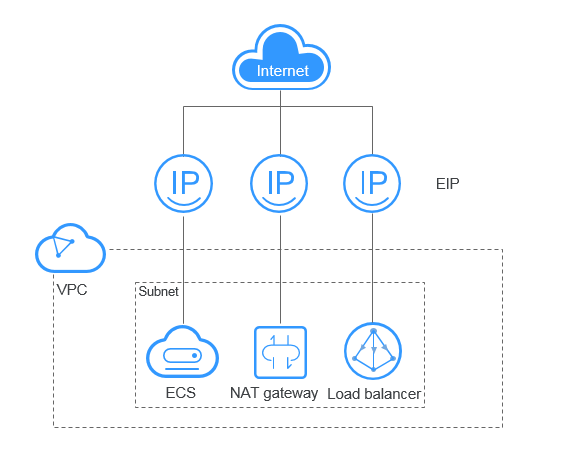Introduction
The Elastic IP (EIP) service enables your cloud resources to communicate with the Internet using static public IP addresses and scalable bandwidths. A resource with an EIP can access the Internet directly, but a resource with only a private IP address cannot.
EIPs can only be bound to resources in the same region.
EIP
EIPs can be bound to or unbound from ECSs, BMSs, virtual IP addresses, NAT gateways, or load balancers.
Each EIP can be bound to only one cloud resource and both should be in the same region.
Figure 1 Connecting to the Internet using an EIP

EIP Bandwidth
Bandwidth refers to the maximum amount of data that can be transmitted in a given amount of time (generally one second). A larger bandwidth value indicates a stronger transmission capability. Bandwidth is classified into public bandwidth and private bandwidth.
Public bandwidth is the bandwidth consumed when data is transferred between the cloud platform and the Internet. Public bandwidth is classified into inbound bandwidth and outbound bandwidth. For details about the outbound bandwidth and inbound bandwidth, see
Figure 2.
- The metrics about outbound bandwidth on the Cloud Eye console are Outbound Bandwidth and Outbound Traffic.
- The metrics about inbound bandwidth on the Cloud Eye console are Inbound Bandwidth and Inbound Traffic.
Figure 2 Inbound bandwidth and outbound bandwidth

Table 1 Inbound bandwidth and outbound bandwidth
|
Type |
Description |
|
Outbound bandwidth |
Bandwidth consumed when data is transferred from the cloud platform to the Internet. For example, the outbound bandwidth is consumed when ECSs provide services accessible from the Internet or when FTP clients download resources from the ECSs. The metrics about outbound bandwidth on the Cloud Eye console are Outbound Bandwidth and Outbound Traffic.
|
|
Inbound bandwidth |
Bandwidth consumed when data is transferred from the Internet to the cloud platform. For example, the inbound bandwidth is consumed when downloading resources from the Internet to ECSs and when FTP clients upload resources to the ECSs. The metrics about inbound bandwidth on the Cloud Eye console are Inbound Bandwidth and Inbound Traffic. |
Accessing EIP
You can access EIPs through the management console or using HTTPS-based APIs.
- Management console
Log in to the management console, select Elastic IP from the console homepage, and then perform operations on EIP resources.
- APIs
If you need to integrate the EIP service provided by the cloud system into a third-party system for secondary development, you can use an API to access the EIP service. For details, see the Elastic IP API Reference.








